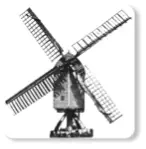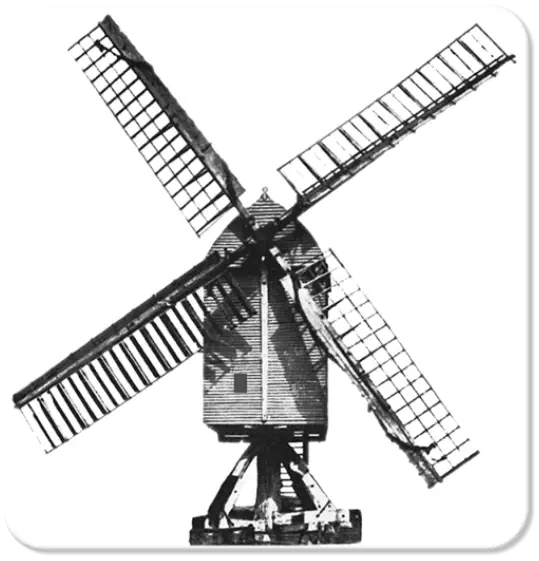In the year 1086, 5624 watermills were mentioned in the Domesday Book. Langham looks
to have been one of five berewicks described as part of the Manor of Oakham making it
difficult to identify if a mill was located here. The disturbed ground by the brook near Cold
Overton Road suggests a mill leet and this may have been the site of Langham’s earliest
water mill.
Windmills were introduced around 1180 and it has been estimated that by 1400 there may
have been over 4000 in England. Many would have replaced the watermills where the
water supply was not satisfactory.
Horsemills were often used for grinding malt. The cost of fodder for the mill horse must have been a
consideration compared with a free supply of water or wind.
1404
In late October or early November at the Court of Edward, Duke of York, held at Oakham, the
Prior of Brook sued for tithes of the mills of Oakham and Langham. These were anciently assessed
at twenty four shillings per annum. Judgement was granted to the Priors of Brook in perpetuity as
they had received the tithes for the previous six years.
1536
Certain mills at Langham were let at a rent of £13 16s 4d. A windmill, in need of repair, as part of the
Manor held by Henry Norris was sold along with another mill, to Sir Andrew Noel, a new kiln house
being built at this time. (VCH 2) A kiln house was used to dry the grain before milling, or to produce
malt for brewing.
1600
The License of Alienation for the Manor of Langham, Gainsborough Papers DE3214/182/2)
mentions two mills.
1607
DE3214/131/25 mentions Mill Close.
1614
Thomas Palmer, miller - Will Northants RO (H 117). No mention of the mill.
1624
Deed of Gift. Gainsborough Papers DE3214/42/10-11 mentions Mill furlonge and gives boundaries.
1624
Map shows a windmill on the Ranksborough side of Cold Overton Road. The road which led up to it
is still traceable and the fields there are called Mill Close on the 1841 tithe map.
1630
Lease dated 20th February. Gainsborough Papers DE3214/131/27 - A windmill in Langham and malt
mill in Langham Town. Stephen Palmer, miller. Rent, weekly each Saturday one half strike of malt and
one strike and a half of corn and grain called mill-corn or maselyn. [Maselyn or maslin was a mixture
of wheat and rye sown together, bread made with the flour was thought to keep fresh longer.]
1674
October 10th - Gainsborough Papers DE3214/131/48. Document mentions close near windmill.
1676
Gainsborough Papers DE3214/231/28. Document mentions three closes between the windmill and
the town.
1683
Lease - Gainsborough Papers DE3214/180/48. Thomas Palmer, miller – son of Stephen Palmer
deceased. Rent paid in cash, capons, and coals.
1699
Lease - Gainsborough Papers DE3214/180/48. To William Brown of Oakham. Messuage in
possession of Ann Bloomfield, widow, includes malt mill in yard of messuage. A later dictionary of
terms describes a malt mill as being small and operated by hand, but this would seem to be
something bigger.
1737
George Roads, millor buried November 14th 1737. (Bishops Transcripts)
1760
Edmund Ripper Map DE3214/M59 shows a windmill on Mill Hill. Maps from 1781 onwards show
windmill there.
1806
December, a serious storm at night when lightening struck the top of the mill, this with the sails and
the axle tree were swept away by the wind. Being a post mill it is unknown whether a new building
was erected but it is recorded that the Bown family who came from Gainsborough milled at the
windmill through the middle of the 19th century. (Wind & Water Mills of Rutland by David Henry).
Anne Grimmer told Freda Smithson that the Bown family are her ancestors. She says that the mill
was not rebuilt but a new one erected on the Burley Road.
1841
Richard Thorpe, Maltster. William Towell, Maltster. William Innocent, Miller, with William Sharman
and John Sewell, Miller’s apprentices. (Census) - See also tithe map and apportionments.
1851
William Innocent and John Sewell were millers. (Census)
1858-81
Robert Bown, miller. (Census)
Millers tended to die early breathing in dust and flour gave them asthma, bronchitis, and other lung diseases.


Langham Village History Group ~ © 1996 - 2025
Mills in Langham - Freda Smithson



In the year 1086, 5624 watermills
were
mentioned in the Domesday Book. Langham looks to have been one of five berewicks
described as part of the Manor of Oakham making it difficult to identify if a mill was
located here. The disturbed ground by the brook near Cold Overton Road suggests a mill
leet and this may have been the site of Langham’s earliest water mill.
Windmills were introduced around 1180 and it has been estimated that by 1400 there may
have been over 4000 in England. Many would have replaced the watermills where the
water supply was not satisfactory.
Horsemills were often used for grinding malt. The cost of fodder for the mill horse must have been a
consideration compared with a free supply of water or wind.
1404
In late October or early November at the Court of Edward, Duke of York, held at Oakham, the
Prior of Brook sued for tithes of the mills of Oakham and Langham. These were anciently assessed
at twenty four shillings per annum. Judgement was granted to the Priors of Brook in perpetuity as
they had received the tithes for the previous six years.
1536
Certain mills at Langham were let at a rent of £13 16s 4d. A windmill, in need of repair, as part of the
Manor held by Henry Norris was sold along with another mill, to Sir Andrew Noel, a new kiln house
being built at this time. (VCH 2) A kiln house was used to dry the grain before milling, or to produce
malt for brewing.
1600
The License of Alienation for the Manor of Langham, Gainsborough Papers DE3214/182/2)
mentions two mills.
1607
DE3214/131/25 mentions Mill Close.
1614
Thomas Palmer, miller - Will Northants RO (H 117). No mention of the mill.
1624
Deed of Gift. Gainsborough Papers DE3214/42/10-11 mentions Mill furlonge and gives boundaries.
1624
Map shows a windmill on the Ranksborough side of Cold Overton Road. The road which led up to it
is still traceable and the fields there are called Mill Close on the 1841 tithe map.
1630
Lease dated 20th February. Gainsborough Papers DE3214/131/27 - A windmill in Langham and malt
mill in Langham Town. Stephen Palmer, miller. Rent, weekly each Saturday one half strike of malt and
one strike and a half of corn and grain called mill-corn or maselyn. [Maselyn or maslin was a mixture
of wheat and rye sown together, bread made with the flour was thought to keep fresh longer.]
1674
October 10th - Gainsborough Papers DE3214/131/48. Document mentions close near windmill.
1676
Gainsborough Papers DE3214/231/28. Document mentions three closes between the windmill and
the town.
1683
Lease - Gainsborough Papers DE3214/180/48. Thomas Palmer, miller – son of Stephen Palmer
deceased. Rent paid in cash, capons, and coals.
1699
Lease - Gainsborough Papers DE3214/180/48. To William Brown of Oakham. Messuage in
possession of Ann Bloomfield, widow, includes malt mill in yard of messuage. A later dictionary of
terms describes a malt mill as being small and operated by hand, but this would seem to be
something bigger.
1737
George Roads, millor buried November 14th 1737. (Bishops Transcripts)
1760
Edmund Ripper Map DE3214/M59 shows a windmill on Mill Hill. Maps from 1781 onwards show
windmill there.
1806
December, a serious storm at night when lightening struck the top of the mill, this with the sails and
the axle tree were swept away by the wind. Being a post mill it is unknown whether a new building
was erected but it is recorded that the Bown family who came from Gainsborough milled at the
windmill through the middle of the 19th century. (Wind & Water Mills of Rutland by David Henry).
Anne Grimmer told Freda Smithson that the Bown family are her ancestors. She says that the mill
was not rebuilt but a new one erected on the Burley Road.
1841
Richard Thorpe, Maltster. William Towell, Maltster. William Innocent, Miller, with William Sharman
and John Sewell, Miller’s apprentices. (Census) - See also tithe map and apportionments.
1851
William Innocent and John Sewell were millers. (Census)
1858-81
Robert Bown, miller. (Census)
Millers tended to die early breathing in dust and flour gave them asthma, bronchitis, and other lung diseases.


Langham Village History Group ~ © 1996 - 2025












![Close [x]](index_htm_files/close.png)










































